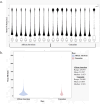Collagen architecture in triple negative breast cancer
- PMID: 40397870
- PMCID: PMC12094767
- DOI: 10.1371/journal.pone.0324655
Collagen architecture in triple negative breast cancer
Abstract
This study evaluated collagen properties in TNBC samples collected from different racial groups to determine the presence of variance in matrix architecture. African American (AA) breast cancer patients have a significantly higher mortality rate and nearly a three-fold increased prevalence of triple negative breast cancer (TNBC) when compared to Caucasian (C) patients. The extracellular matrix region surrounding tumors contains abundant collagen fibers, and these fibers undergo remodeling throughout cancer progression, promote metastasis, and impede treatment response. High mammographic density, commonly known as dense breast tissue, is hypothesized to be more prevalent in AA women and characterized by increased collagen deposition and associated with more aggressive cancers. The aim of this research was to investigate fibrillar collagen architecture in TNBC samples from AA and C patients using two-photon microscopy with second harmonic generation (SHG), an intrinsic optical signal produced by fibrillar collagen. Twenty tissue regions per tumor sample were randomly selected for SHG microscopy, and image processing was conducted using the Fiji macro TWOMBLI to quantify mesoscopic fibrillar morphological properties and nanoscopic fibrillar properties with the Forward-Backward SHG ratio. Compared to the images from C tumor samples, those from AA samples exhibited a significant increase in parameters including fiber area, total length, and number of endpoints and branchpoints, but had decreased lacunarity. Collagen microstructure, including fibril arrangement and packing density, did not significantly differ between the groups. These results illustrate that the TNBC samples analyzed from AA patients may have macrostructural collagen characteristics associated with aggressive phenotype tumor formation.
Copyright: © 2025 Dinkel et al. This is an open access article distributed under the terms of the Creative Commons Attribution License, which permits unrestricted use, distribution, and reproduction in any medium, provided the original author and source are credited.
Conflict of interest statement
The authors have declared that no competing interests exist.
Figures





Similar articles
-
Comparative Analysis of Breast Cancer Phenotypes in African American, White American, and West Versus East African patients: Correlation Between African Ancestry and Triple-Negative Breast Cancer.Ann Surg Oncol. 2016 Nov;23(12):3843-3849. doi: 10.1245/s10434-016-5420-z. Epub 2016 Jul 28. Ann Surg Oncol. 2016. PMID: 27469125
-
Quantitative stain-free imaging and digital profiling of collagen structure reveal diverse survival of triple negative breast cancer patients.Breast Cancer Res. 2020 May 6;22(1):42. doi: 10.1186/s13058-020-01282-x. Breast Cancer Res. 2020. PMID: 32375854 Free PMC article.
-
LOXL4 knockdown enhances tumor growth and lung metastasis through collagen-dependent extracellular matrix changes in triple-negative breast cancer.Oncotarget. 2017 Feb 14;8(7):11977-11989. doi: 10.18632/oncotarget.14450. Oncotarget. 2017. PMID: 28060764 Free PMC article.
-
Racial Disparities in Triple Negative Breast Cancer: A Review of the Role of Biologic and Non-biologic Factors.Front Public Health. 2020 Dec 22;8:576964. doi: 10.3389/fpubh.2020.576964. eCollection 2020. Front Public Health. 2020. PMID: 33415093 Free PMC article. Review.
-
Ethnic disparities in the immune microenvironment of triple negative breast cancer and its role in therapeutic outcomes.Cancer Rep (Hoboken). 2023 Sep;6 Suppl 1(Suppl 1):e1779. doi: 10.1002/cnr2.1779. Epub 2023 Jan 12. Cancer Rep (Hoboken). 2023. PMID: 36632988 Free PMC article. Review.
References
-
- Giaquinto AN, Sung H, Miller KD, Kramer JL, Newman LA, Minihan A, et al.. Breast Cancer Statistics, 2022. CA Cancer J Clin. 2022. Nov;72(6):524–41. - PubMed
-
- Reddy GM. Clinicopathological features of triple negative breast carcinoma. J Clin Diagn Res [Internet]. 2017. [cited 2023 Nov 6]; Available from: http://jcdr.net/article_fulltext.asp?issn=0973-709x&year=2017&volume=11&... - PMC - PubMed
MeSH terms
Substances
Grants and funding
LinkOut - more resources
Full Text Sources

